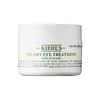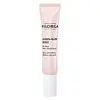What's inside
What's inside
 Key Ingredients
Key Ingredients

 Benefits
Benefits

 Concerns
Concerns

 Ingredients Side-by-side
Ingredients Side-by-side

Water
Skin ConditioningButyrospermum Parkii Butter
Skin ConditioningButylene Glycol
HumectantTridecyl Stearate
EmollientPEG-30 Dipolyhydroxystearate
EmulsifyingIsodecyl Salicylate
Skin ConditioningTridecyl Trimellitate
EmollientPersea Gratissima Oil
Skin ConditioningIsocetyl Stearoyl Stearate
EmollientPropylene Glycol
HumectantDipentaerythrityl Hexacaprylate/Hexacaprate
EmulsifyingSorbitan Sesquioleate
EmulsifyingMagnesium Sulfate
Hydrogenated Castor Oil
EmollientSodium PCA
HumectantPhenoxyethanol
PreservativeChlorphenesin
AntimicrobialHydrogenated Jojoba Oil
AbrasiveP-Anisic Acid
MaskingTocopheryl Acetate
AntioxidantIsopropyl Palmitate
EmollientDisodium EDTA
Copper PCA
HumectantHelianthus Annuus Seed Oil
EmollientCI 40800
Cosmetic ColorantCitric Acid
BufferingWater, Butyrospermum Parkii Butter, Butylene Glycol, Tridecyl Stearate, PEG-30 Dipolyhydroxystearate, Isodecyl Salicylate, Tridecyl Trimellitate, Persea Gratissima Oil, Isocetyl Stearoyl Stearate, Propylene Glycol, Dipentaerythrityl Hexacaprylate/Hexacaprate, Sorbitan Sesquioleate, Magnesium Sulfate, Hydrogenated Castor Oil, Sodium PCA, Phenoxyethanol, Chlorphenesin, Hydrogenated Jojoba Oil, P-Anisic Acid, Tocopheryl Acetate, Isopropyl Palmitate, Disodium EDTA, Copper PCA, Helianthus Annuus Seed Oil, CI 40800, Citric Acid
Water
Skin ConditioningC10-18 Triglycerides
EmollientCaprylic/Capric Triglyceride
MaskingHeptyl Undecylenate
EmollientGlycerin
HumectantPropanediol
SolventEthylhexyl Palmitate
EmollientGlyceryl Stearate
EmollientPEG-100 Stearate
Butylene Glycol
HumectantSodium Citrate
BufferingMaltodextrin
AbsorbentHydroxyethyl Acrylate/Sodium Acryloyldimethyl Taurate Copolymer
Emulsion StabilisingArginine PCA
HumectantCetyl Alcohol
EmollientGluconolactone
Skin ConditioningHydrogenated Olive Oil Stearyl Esters
Emulsion StabilisingMannitol
HumectantParfum
MaskingSucrose Dilaurate
EmollientMaris Aqua
HumectantSimmondsia Chinensis Seed Oil
EmollientTribehenin
EmollientSucrose Palmitate
EmollientHydroxyacetophenone
AntioxidantCaprylyl Glycol
EmollientCitric Acid
BufferingSodium Hydroxide
BufferingPolyacrylate Crosspolymer-6
Emulsion StabilisingSodium Cocoyl Glutamate
CleansingTocopherol
AntioxidantHelianthus Annuus Seed Oil
EmollientLecithin
EmollientLysolecithin
EmulsifyingGlyceryl Linoleate
EmollientPaeonia Albiflora Root Extract
Skin ConditioningPrunus Amygdalus Dulcis Oil
Skin ConditioningPisum Sativum Extract
Skin ConditioningPolysorbate 60
EmulsifyingSorbitan Isostearate
EmulsifyingSodium Chloride
MaskingBorago Officinalis Seed Oil
EmollientOenothera Biennis Oil
EmollientCamellia Oleifera Seed Oil
Skin ConditioningCI 77891
Cosmetic ColorantSynthetic Fluorphlogopite
Trihydroxystearin
Skin ConditioningNiacinamide
Smoothing3-O-Ethyl Ascorbic Acid
Skin ConditioningLactobacillus Ferment
Skin ConditioningPotassium Azeloyl Diglycinate
Skin ConditioningSodium Phytate
Ceramide NP
Skin ConditioningSodium Hyaluronate
Humectant1,2-Hexanediol
Skin ConditioningGlucose
HumectantPhenoxyethanol
PreservativeBisabolol
MaskingPotassium Chloride
Beta-Sitosterol
Emulsion StabilisingPhytic Acid
Squalene
EmollientPotassium Sorbate
PreservativeCalcium Chloride
AstringentSophora Japonica Flower Extract
Skin ProtectingAcetyl Tetrapeptide-11
Skin ConditioningMagnesium Sulfate
Glutamine
Skin ConditioningAcetyl Tetrapeptide-9
Skin ConditioningTin Oxide
AbrasiveCI 19140
Cosmetic ColorantSodium Phosphate
BufferingAscorbic Acid
AntioxidantSodium Acetate
BufferingLysine Hcl
Skin ConditioningArginine Hcl
Skin ConditioningAlanine
MaskingCI 17200
Cosmetic ColorantHistidine Hcl
Skin ConditioningValine
MaskingLeucine
Skin ConditioningThreonine
Isoleucine
Skin ConditioningTryptophan
MaskingPhenylalanine
MaskingTyrosine
MaskingGlycine
BufferingPolysorbate 80
EmulsifyingGlucomannan
Skin ConditioningSerine
MaskingCystine
MaskingCyanocobalamin
Skin ConditioningGlutathione
Asparagine
MaskingAspartic Acid
MaskingOrnithine Hcl
Skin ConditioningGlutamic Acid
HumectantNicotinamide Adenine Dinucleotide
Skin ConditioningProline
Skin ConditioningMethionine
Skin ConditioningTaurine
BufferingHydroxyproline
Skin ConditioningGlucosamine Hcl
Coenzyme A
Skin ConditioningSodium Glucuronate
HumectantThiamine Diphosphate
Skin ConditioningRetinyl Acetate
Skin ConditioningInositol
HumectantNiacin
SmoothingPyridoxine Hcl
Skin ConditioningBiotin
AntiseborrhoeicCalcium Pantothenate
Riboflavin
Cosmetic ColorantSodium Tocopheryl Phosphate
AntioxidantThiamine Hcl
MaskingFolic Acid
Skin ConditioningWater, C10-18 Triglycerides, Caprylic/Capric Triglyceride, Heptyl Undecylenate, Glycerin, Propanediol, Ethylhexyl Palmitate, Glyceryl Stearate, PEG-100 Stearate, Butylene Glycol, Sodium Citrate, Maltodextrin, Hydroxyethyl Acrylate/Sodium Acryloyldimethyl Taurate Copolymer, Arginine PCA, Cetyl Alcohol, Gluconolactone, Hydrogenated Olive Oil Stearyl Esters, Mannitol, Parfum, Sucrose Dilaurate, Maris Aqua, Simmondsia Chinensis Seed Oil, Tribehenin, Sucrose Palmitate, Hydroxyacetophenone, Caprylyl Glycol, Citric Acid, Sodium Hydroxide, Polyacrylate Crosspolymer-6, Sodium Cocoyl Glutamate, Tocopherol, Helianthus Annuus Seed Oil, Lecithin, Lysolecithin, Glyceryl Linoleate, Paeonia Albiflora Root Extract, Prunus Amygdalus Dulcis Oil, Pisum Sativum Extract, Polysorbate 60, Sorbitan Isostearate, Sodium Chloride, Borago Officinalis Seed Oil, Oenothera Biennis Oil, Camellia Oleifera Seed Oil, CI 77891, Synthetic Fluorphlogopite, Trihydroxystearin, Niacinamide, 3-O-Ethyl Ascorbic Acid, Lactobacillus Ferment, Potassium Azeloyl Diglycinate, Sodium Phytate, Ceramide NP, Sodium Hyaluronate, 1,2-Hexanediol, Glucose, Phenoxyethanol, Bisabolol, Potassium Chloride, Beta-Sitosterol, Phytic Acid, Squalene, Potassium Sorbate, Calcium Chloride, Sophora Japonica Flower Extract, Acetyl Tetrapeptide-11, Magnesium Sulfate, Glutamine, Acetyl Tetrapeptide-9, Tin Oxide, CI 19140, Sodium Phosphate, Ascorbic Acid, Sodium Acetate, Lysine Hcl, Arginine Hcl, Alanine, CI 17200, Histidine Hcl, Valine, Leucine, Threonine, Isoleucine, Tryptophan, Phenylalanine, Tyrosine, Glycine, Polysorbate 80, Glucomannan, Serine, Cystine, Cyanocobalamin, Glutathione, Asparagine, Aspartic Acid, Ornithine Hcl, Glutamic Acid, Nicotinamide Adenine Dinucleotide, Proline, Methionine, Taurine, Hydroxyproline, Glucosamine Hcl, Coenzyme A, Sodium Glucuronate, Thiamine Diphosphate, Retinyl Acetate, Inositol, Niacin, Pyridoxine Hcl, Biotin, Calcium Pantothenate, Riboflavin, Sodium Tocopheryl Phosphate, Thiamine Hcl, Folic Acid
 Reviews
Reviews

Alternatives
Ingredients Explained
These ingredients are found in both products.
Ingredients higher up in an ingredient list are typically present in a larger amount.
Butylene Glycol (or BG) is used within cosmetic products for a few different reasons:
Overall, Butylene Glycol is a safe and well-rounded ingredient that works well with other ingredients.
Though this ingredient works well with most skin types, some people with sensitive skin may experience a reaction such as allergic rashes, closed comedones, or itchiness.
Learn more about Butylene GlycolCitric Acid is an alpha hydroxy acid (AHA) naturally found in citrus fruits like oranges, lemons, and limes.
Like other AHAs, citric acid can exfoliate skin by breaking down the bonds that hold dead skin cells together. This helps reveal smoother and brighter skin underneath.
However, this exfoliating effect only happens at high concentrations (20%) which can be hard to find in cosmetic products.
Due to this, citric acid is usually included in small amounts as a pH adjuster. This helps keep products slightly more acidic and compatible with skin's natural pH.
In skincare formulas, citric acid can:
While it can provide some skin benefits, research shows lactic acid and glycolic acid are generally more effective and less irritating exfoliants.
Most citric acid used in skincare today is made by fermenting sugars (usually from molasses). This synthetic version is identical to the natural citrus form but easier to stabilize and use in formulations.
Read more about some other popular AHA's here:
Learn more about Citric AcidHelianthus Annuus Seed Oil is the oil derived from the seeds of a Sunflower. Sunflower seed oil is non-fragrant. It is an emollient, meaning it helps to soften the skin.
Sunflower seed oil contains many fatty acids. The fatty acids found in sunflower seeds include (from highest amount to least): linoleic acid, myristic acid, palmitic acid, stearic acid, arachidic acid, oleic acid, and linolenic acid.
These fatty acids help the skin create ceramides. Ceramides play a role in repairing the skin barrier.
Helianthus Annuus Seed Oil helps moisturize the skin. This in turn helps the skin look more rejuvenated and smoother.
Sunflowers are rich in vitamin E.
Historians believe Indigenous cultures of North America domesticated sunflowers before corn. Thus they relied on sunflower oil for a variety of uses. One such use is moisturizing skin and hair.
Sunflower seed oil may not be fungal acne safe. We recommend speaking with a professional if you have any concerns.
Learn more about Helianthus Annuus Seed OilMagnesium Sulfate is a salt. More specifically, it is an epsom salt, or the bath salt used to help relieve muscle aches.
Despite having ‘sulfate’ in the name, it isn’t a surfactant or cleansing agent like sodium lauryl sulfate. Unlike those sulfates, magnesium sulfate doesn’t have the same cleansing or foaming properties (it's simply a type of salt).
In cosmetics, Magnesium Sulfate is used to thicken a product or help dilute other solids. It is a non-reactive and non-irritating ingredient.
One study shows magnesium deficiency may lead to inflammation of the skin. Applying magnesium topically may help reduce inflammation.
You can find this ingredient in sea water or mineral deposits.
Learn more about Magnesium SulfatePhenoxyethanol is a preservative that has germicide, antimicrobial, and aromatic properties. Studies show that phenoxyethanol can prevent microbial growth. By itself, it has a scent that is similar to that of a rose.
It's often used in formulations along with Caprylyl Glycol to preserve the shelf life of products.
Water. It's the most common cosmetic ingredient of all. You'll usually see it at the top of ingredient lists, meaning that it makes up the largest part of the product.
So why is it so popular? Water most often acts as a solvent - this means that it helps dissolve other ingredients into the formulation.
You'll also recognize water as that liquid we all need to stay alive. If you see this, drink a glass of water. Stay hydrated!
Learn more about Water